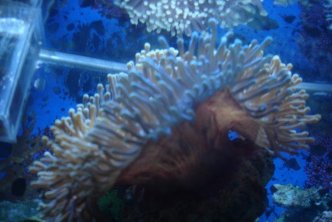|
Interactions |
|
Heteractis magnifica form symbiotic relationships with many sea-dwellers. These organisms include shrimp, crab, algae, and probably the most commonly known: clownfish. |
|||||||||||||
| Heteractis magnifica are one of ten species of anemones to host anemonefish, most coming from the genus Amphiprion. Both organisms benefit from this relationship, so it is also referred to as mutualism. The clownfish will gain by using the anemone for protection, such as hiding within its stinging tentacles and will also lay its eggs beneath the oral disc overhang for addition security. In turn, the clownfish will help chase any predator from nibbling at the anemone and will provide it with added nutrients from its own waste. |
A pair of clownfish living within their
host anemone |
||||||||||||
|
The symbiotic relationship between shrimp and crab and Heteractis magnifica is limited. Since the shrimp and crab are not "immune" to the stinging tentacles, they are restricted to scuttling under the oral disc overhang. Here they forage for small particles of food and clean the underside of the anemone. |
|||||||||||||
|
|
|||||||||||||
|
Single-celled species of green algae can also be found living on the tentacles of Heteractis magnifica. Since the anemone live in shallow waters, the algae receive high amounts of sunlight. They are also protected from being eaten by herbivores. In turn, the anemone receive oxygen and glucose released from the algae through photosynthesis. Sometimes, this sugar will be the anemone's only source of food. | ||||||||||||
| Human beings also interact with Heteractis magnifica. This species of anemone is one of the most common for home aquariums. They are usually taken straight from the ocean and sold to distributors. Although they do survive well in aquaria, the Ritteri Anemone is considered to be one of the most challenging species of anemone to keep healthy. Even though it is hard work, people like to own Heteractis magnifica because clownfish take so easily to them. | |||||||||||||
|
Home
aquarium with Heteractis magnifica (upper right) |
|||||||||||||
